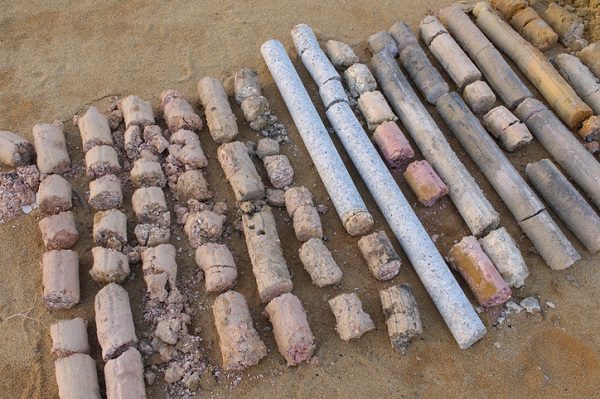Browsing Geotechnical Solutions: The Significance of Geotechnical News, Soil Compaction Screening, and Pavement Layout in Ensuring Structural Stability
Geotechnical solutions, incorporating the production of geotechnical reports, carrying out soil compaction screening, and thorough sidewalk design, serve as the cornerstone of making certain structural honesty. geotheta. These essential elements not only lay the groundwork for successful job implementation yet also reduce possible threats that might endanger the stability and durability of a construction job.
Value of Geotechnical Records
Geotechnical records play a critical duty in giving thorough understandings right into the dirt and rock problems of a site, vital for making sure the architectural stability of building projects. These reports are a fundamental part of the initial website investigation process, offering valuable details that affects the style, building methods, and total usefulness of a job. By evaluating soil make-up, security, and prospective risks such as landslides or sinkholes, geotechnical reports make it possible for designers to make educated decisions pertaining to foundation design and building and construction methods.
Additionally, geotechnical reports aid in danger assessment and reduction methods, assisting task stakeholders comprehend the potential obstacles that may arise throughout construction. Via complete evaluation and analysis of geotechnical data, designers can establish remedies to attend to site-specific issues, making sure the long-term security and safety of the framework. Ultimately, the detailed nature of geotechnical reports acts as a crucial structure for effective job preparation and execution, lessening risks and improving total project results.

Duty of Dirt Compaction Testing
How essential is the analysis of dirt compaction via screening for making certain the security and long life of building projects? Dirt compaction screening plays an essential role in the building market by guaranteeing that the soil below a structure is appropriately compacted to support the intended lots and protect against settlement (geotheta). Appropriately compressed dirt gives a secure foundation for buildings, roadways, and various other structures, reducing the threat of architectural failing and expensive repair work in the future
Soil compaction screening includes determining the density of the dirt and contrasting it to the maximum thickness attainable for that specific dirt kind. This assists engineers establish if the dirt has been compressed adequately to support the scheduled structure. By carrying out soil compaction examinations during building and construction, designers can identify any kind of areas that call for extra compaction and take corrective measures before continuing with further building and construction.
Value of Sidewalk Design
Assessing dirt compaction via screening not only guarantees the stability and longevity of construction tasks yet likewise lays a vital foundation for effective sidewalk layout. Correct pavement layout takes into consideration aspects such as traffic load, ecological problems, soil features, and product residential properties to produce a robust and lasting surface area. By incorporating information from dirt compaction tests, engineers can determine the ideal thickness, products, and layering for the sidewalk to withstand awaited anxieties and maintain architectural stability over time.
Ensuring Architectural Integrity
These records supply vital info on dirt make-up, stability, and potential dangers, assisting in notified decision-making throughout the design and building and construction stages. In addition, performing detailed soil compaction testing is important to make certain that the dirt beneath sidewalks or structures is properly compressed to sustain the intended lots and protect against settlement concerns.
Moreover, implementing robust sidewalk layout practices is important for guaranteeing the architectural stability of roads, car park whole lots, and various other smooth surfaces. Appropriate pavement design takes into consideration variables such as traffic volume, environmental conditions, and dirt qualities to develop safe and resilient transportation infrastructure. By sticking to these methods and making use of geotechnical services properly, building and construction projects can improve their structural honesty, decrease dangers of failing, and make certain the lasting performance of the constructed atmosphere.
Securing Versus Risks
Due to the important relevance positioned on making sure structural honesty via thorough interest to material option and soil screening, safeguarding against risks becomes critical in maintaining the stability and longevity of construction tasks. Threats in construction tasks can stem from various resources, consisting of all-natural disasters, dirt instability, or design problems. To guard against these threats, complete risk analysis processes should be executed at every phase of the project. This includes detailed geotechnical investigations to identify prospective risks, such as soil erosion or seismic task, that can jeopardize the job's security.
Furthermore, creating contingency strategies and carrying out durable tracking systems can aid alleviate unpredicted risks that might occur throughout building and construction. Routine assessments and top quality control steps must be executed to make certain that materials are made use of according to specs which building and construction techniques comply with market criteria. By proactively determining and dealing with prospective dangers, building and construction tasks can improve their strength and minimize the possibility of structural failings, inevitably making sure the find more information security and durability of the developed setting.
Verdict

Dirt compaction screening plays a vital function in the building and construction sector by ensuring that the soil underneath a framework is effectively compacted to support the use this link desired tons and prevent negotiation.Dirt compaction testing involves measuring the thickness of the dirt and comparing it to the maximum thickness achievable for that particular dirt kind (geotheta). By carrying out dirt compaction examinations throughout building and construction, designers can recognize any type of areas that call for additional compaction and take restorative actions prior to proceeding with additional building and construction
Additionally, conducting extensive soil compaction testing is important to ensure that the dirt beneath structures or pavements is appropriately compressed to sustain the designated loads and protect against settlement issues.
In final thought, geotechnical records, soil compaction testing, and pavement layout play vital roles in ensuring the structural honesty of building and construction jobs.
Comments on “How Geotheta is Changing Modern Geotechnical Evaluation and Development”